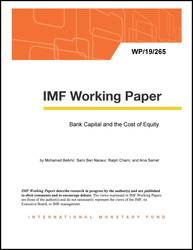
Bank Capital and the Cost of Equity
Using a sample of publicly listed banks from 62 countries over the 1991-2017 period, we investigate the impact of capital on banks’ cost of equity. Consistent with the theoretical prediction that more equity in the capital mix leads to a fall in firms’ costs of equity, we find that better capitalized banks enjoy lower equity costs. Our baseline estimations indicate that a 1 percentage point increase in a bank’s equity-to-assets ratio lowers its cost of equity by about 18 basis points. Our results also suggest that the form of capital that investors value the most is sheer equity capital; other forms of capital, such as Tier 2 regulatory capital, are less (or not at all) valued by investors. Additionally, our main finding that capital has a negative effect on banks’ cost of equity holds in both developed and developing countries. The results of this paper provide the missing evidence in the debate on the effects of higher capital requirements on banks’ funding costs.
Publication date: December 2019
ISBN: 9781513519807
$18.00
Add to Cart by clicking price of the language and format you'd like to purchase
Available Languages and Formats
| English |
Prices in red indicate formats that are not yet available but are forthcoming.
Topics covered in this book
This title contains information about the following subjects.
Click on a subject if you would like to see other titles with the same subjects.
Cost of equity , Banking regulation , Financial stability , WP , Coe , country-level , ROA , equity
Also of interest
Summary
Copyright © 2010 - 2025
Powered by:
AIDC



